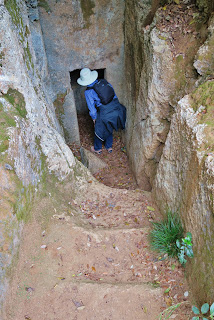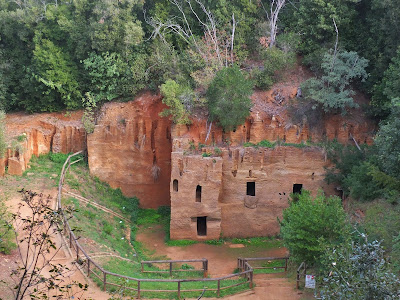A Weekend Trip in Tuscany - Piombino and Populonia.
Midway from Rome to Florence - Visit & Discover the Largest Etruscan City on the Sea.
We think of the Roman Empire as one of the wellsprings of civilization, as an ancient and powerful state that enabled the rise of western culture. But before Roman times, when the Etruscans were in charge, Rome was a farming village, low on the scale of desirable property. The Etruscan civilization flourished for over half a millennium, from about 900 BC to 300 BC, and left intriguing traces of industry and wealth in many of their ancient centers. Populonia, now a part of Piombino, was once a busy center for Etruscan trade, and was renowned as a smelting facility, since deposits of iron, copper and tin were plentiful in the region. They minted coins, worked metal, grew wine, and traded extensively with Sardinia. Funeral customs were important to the Etruscans, and they buried their dead with painstaking care in special buildings with many personal effects.
 |
| Down to the sea. Piombino. |
You can have a wonderful introduction to this civilization by visiting Piombino, a rather small (35,000) city in Tuscany just south of Livorno. Most visitors hurry through Piombino on their way the the island of Elba on the ferry from Piombino. That would be a shame - the town is well worth a stop. It makes a great weekend jaunt, and also an excellent stopover when traveling between Rome and Florence. It is packed with interest for history buffs and perfect for kids who are intrigued by hikes, tombs, rocks, or metals. The complete trip really needs a car, although rail connections are possible to Piombino.
 |
| Old town Piombino. Corso Emanuele. |
The historic center of Piombino is small and full of one way streets, but parking is relatively easy on the perimeter, and after you settle in, most of the parts of town you'll want to see are in pedestrian zones. The small cobbled main street winds through the old town to the sea, where there is a walk along the water and a fabulous view of the surrounding islands that make up the Tuscan archipelago, including Elba. The street is lined with restaurants featuring – what else? – fresh seafood. We had lunch at Osteria Mamma Carla, where the staff are friendly, the octopus salad is wonderful and the spaghetti allo scoglio delicious.
 |
| Roman mosiac with a squid in sunglasses. Museum of Populonia, Piombino.. |
 |
| Sunset over Elba Island and the Piombino Lungomare. |
 |
| Tomb of the Bronze Fans (Tombe dei Flabelli di Bronzo) from about 630 BC. The tomb was found intact with jewelry, weapons, and kitchen utensils. |
The site has two main sections. The first is the lower area, a gently sloping hill in front of the Welcome Center, filled with
ancient above-ground tombs. The second is on a nearby wooded hillside. A pretty, winding trail connects the sites.
In the lower area the most prominent and enormous site is the Tomb of the Chariot from around 850 BC. This restored tomb was for an aristocratic family and has been fully restored. It features a domed roof and the structure is 28 meters (over 90 feet) in diameter. It's normally kept locked, but there are frequent visits facilitated by park guides, and we were lucky enough to be just in time for one. The door to the tomb is, unfortunately for the one of us over 6 feet tall, rather short. In fact, you have to pretty much bend over double and duckwalk through the corridor to the center area. Inside are three rooms, two for precious and symbolic objects, and one for the dead with four individual resting places, funerary beds - like earthen camp beds. The remains would rest here, but perhaps not for eternity - in some eras it was just until later family members needed to begin their final journey.
 |
| Dome of the burial chamber of the Tomb of the Chariots (Tomba dei Carri) which. held parts of war and processional chariots. |
In the lower area the most prominent and enormous site is the Tomb of the Chariot from around 850 BC. This restored tomb was for an aristocratic family and has been fully restored. It features a domed roof and the structure is 28 meters (over 90 feet) in diameter. It's normally kept locked, but there are frequent visits facilitated by park guides, and we were lucky enough to be just in time for one. The door to the tomb is, unfortunately for the one of us over 6 feet tall, rather short. In fact, you have to pretty much bend over double and duckwalk through the corridor to the center area. Inside are three rooms, two for precious and symbolic objects, and one for the dead with four individual resting places, funerary beds - like earthen camp beds. The remains would rest here, but perhaps not for eternity - in some eras it was just until later family members needed to begin their final journey.
 |
| A Shrine Tomb. Tomb architecture evolved over time. Archaeological Park of Baratti and Populonia |
 |
| Populonia Underground Tomb |
Near the top, the Vie Cave trail veers right, and the tombs start to reveal themselves. These tombs are dug down into the hillside, accessed by steep stone steps carved into the underlying limestone. They are impressively deep, 20 feet or so, and at the shadowy bottom of the staircase is the burial room where traces of the indents for sarcophagi still survive. A few of the tombs are cordoned off, but you can climb down into many of the sites.
There are beautiful views over the countryside and to the sea from the trail which winds through the forest. You walk past several Etruscan quarry sites which now look like little overgrown cliffs. The Etruscan were good at quarrying stone blocks from this limestone for trading and for building. Soon the trail opens onto an overview of the largest quarry site which - in the manner of real estate developers of every age - was then re-purposed to build the Necropoli delle Grotte, a sort of tenement tomb. (Engineers should not miss the partially excavated limestone block on the side of the building.)
 |
| Necropoli delle Grotte Archaeological Park of Baratti and Populonia |
More Info
Ancient History Encyclopedia on Populonia
Martha's Italy in Populonia
Wandering Italy Piombino & Elba Island
Piombino Tourism Website
Park of Baratti & Populonia Website
Written by Martha, Photos by Mike.

